Dr. Pat Zukeran explores the radical differences between Muhammad and Jesus, and the implications of following their examples and teachings.
Muhammad and Jesus are the founders of the two largest religions in the world and two of the most influential people in the history of the world. Both men serve not only as founders but also the ideal models whose lives are to be emulated by all their followers. What kind of lives did they live? What example did they leave behind, and how is their example impacting our world today?
 This work will examine the lives of both men. In my research I have relied on what is considered by Muslims to be some of the most authoritative historical sources on the life of Muhammad. The first source is the Qur’an, the inspired text of Islam. Second is the Hadith, a record of the many sayings and the life events of Muhammad. The most recognized collection is by Ismail Sahih Bukhari, written in 870. Third is the first and most authoritative biography of Muhammad, written by Ibn Ishaq nearly 150 years after Muhammad’s death.
This work will examine the lives of both men. In my research I have relied on what is considered by Muslims to be some of the most authoritative historical sources on the life of Muhammad. The first source is the Qur’an, the inspired text of Islam. Second is the Hadith, a record of the many sayings and the life events of Muhammad. The most recognized collection is by Ismail Sahih Bukhari, written in 870. Third is the first and most authoritative biography of Muhammad, written by Ibn Ishaq nearly 150 years after Muhammad’s death.
In examining the life of Jesus, I relied primarily on the New Testament. The four Gospels are biographies of His life. Matthew, Mark, and Luke were written prior to AD 70, and John was written in AD 95. The letters of the New Testament written by His disciples also serve as a historical source. Most were written prior to AD 70 while some, like 1 Corinthians, were written as early as AD 55.
Muslims believe that Muhammad is the perfect example to follow in all aspects of life. The Qur’an states that in Muhammad, “Ye have indeed in the Apostle of God a beautiful pattern and excellent model of conduct” (Surah 33:21). It also states that Muhammad demonstrates “an excellent standard of character” (Surah 68:4).
The Qur’an also emphasizes that obedience to Muhammad’s teachings is equivalent to obeying Allah, as evidenced when Surah 4:80 states that “he who obeys the Apostle, obeys Allah.” Moreover, Surah 4:115 also reflects how highly Muslims revere Muhammad as it explains the fate of one who disobeys: “If anyone contends with the Apostle even after guidance has been plainly conveyed to him, and follows a path other than that becoming to men of faith, we shall leave him in the path he has chosen, and land him in Hell—what an evil refuge.”
Muslims are called to imitate Muhammad in all aspects of their lives, even in their daily activities. Islamic scholar John Esposito writes, “Muslims look to Muhammad’s example for guidance in all aspects of life: how to treat friends as well as enemies, what to eat and drink, how to make love and war. . . . His impact on Muslim life cannot be overestimated, since he served as both religious and political head of Medina: prophet of God, ruler, military commander, chief judge, lawgiver. . . . Traditions of the Prophet provide guidance for personal hygiene, dress, eating, marriage, treatment of wives, diplomacy, and warfare.”{1}
Christians are not called to copy Christ in all aspects of their lives as Muslims do Muhammad. Rather, Christians are called to reflect the character, mindset, and attitude of Christ (1 Corinthians 11:1, Philippians. 2:5, 1 Peter 2:21). Christ focused on the inner transformation of the heart and mind of the individual which would result in righteous living (Matthew 5:8, 6:21, 15:8, 18).
When making decisions in their lives, Muslims will ask, “What would Muhammad do?” while Christians ask, “What would Jesus do?” Since these two men serve as models of perfect conduct for their followers to imitate, it is important to learn what kind of lives they lived. This work will present a brief overview and highlight key events in the lives of each person as we explore that which can be learned from their examples.
The Call of Muhammad and Jesus
Muhammad and Jesus lived remarkable yet radically different lives. Muhammad was born in AD 570. His family was part of the Quraysh tribe, which oversaw the Mecca temple where the deities of Arabia were worshipped. His father died when he was very young, and his mother died when he was six. He was raised by his grandfather and later by his uncle. At the age of twenty-five, he married Khadija, his employer, who was fifteen years his elder.
At the age of forty, Muhammad received his first visitation from the angel Gabriel. According to Ibn Ishaq, the giving and receiving of the revelation was quite violent in nature. Gabriel came to Muhammad and ordered him to read his message. Being illiterate, Muhammad asked Gabriel, “What shall I read?” It is then Gabriel pressed Muhammad so hard that Muhammad thought he was going to die. This was repeated three times until Muhammad read the following message from Gabriel: “Read in the name of thy Lord who created, who created man of blood coagulated. Read! Thy Lord is the most beneficent, who taught by the pen, taught that which they knew not unto men.” After this the angel Gabriel departed.{2}
Muhammad was terrified by this incident. Bukhari records that Muhammad returned home trembling and sought to hide under a blanket. His first thought was that he had come under demonic influence.{3} In fact, he was so troubled that he became suicidal. Ishaq records that since Muhammad did not want anyone in his tribe to discover that he was possessed, he resolved to go to the top of a mountain and commit suicide.{4} However, his wife and her cousin Waraqa, an Ebionite Christian, encouraged him that he was not possessed but rather a prophet of God.{5} Through their encouragement, he came to believe that he had received a divine message from Allah.
Prior to his encounter with Gabriel and throughout his life, Muhammad struggled with demonic possession. Ishaq records an incident during Muhammad’s childhood when his foster parents, al-Harith and Halima, were raising him. One day while behind the tents, two men clothed in white threw Muhammad to the ground, opened up his belly, and searched through it. His foster father felt the boy might have suffered a stroke. Halima, his foster mother who had nursed Muhammad, believed a demon had possessed him.{6}
Another account of Muhammad’s struggle with demon possession occurred a few years after his prophetic calling when Muhammad believed he received a revelation allowing Muslims to worship the three gods of the Quraysh. However, he later admitted that Satan possessed him when he uttered those verses.{7} Allah eventually forgave Muhammad but gave him a stern warning recorded in Surah 17:73-75. Also another time after his prophetic calling Muhammad fell under the spell of a Jewish magician named Labid for one year.{8}
In contrast, biblical prophets and apostles clearly understood their visions were from God rather than Satan or demons. Although some were frightened by their vision of God or the angels before them, they were not violently handled. Instead they were given an assuring introductions such as “Do not be afraid” (Luke 1:13, 28-30, 2:10, Isa. 6:6-7, Revelation 1:17). Jesus’ birth was miraculous, and He understood His mission from His childhood (Luke 2:41-52). Throughout His life, Jesus clearly distinguished between God’s message and Satan’s. During His temptation in the desert, He did not struggle with possession but instead defeated Satan’s attacks using the word of God. Throughout His ministry, Jesus demonstrated authority over the demonic realm, and the demons were terrified of Him (Matthew 8:16, Luke 8:26-39). Through His death and resurrection, Jesus defeated Satan and the demonic hosts. Paul states that Jesus “disarmed the rulers and authorities and put them to open shame by triumphing over them in Him” (Colossians 2:15).
The contrast is readily apparent. One man struggled from demonic presence in his life; the other conquered the devil.
The Warrior and the Rabbi
At the beginning of their mission, both Muhammad and Jesus began preaching in their home territory, and both were persecuted for their message. However, the two responded very differently to their opposition. Muhammad resorted to the use of force while Jesus pursued the path of peace.
Muhammad began preaching in Mecca. During his thirteen years preaching in Mecca he preached a message of tolerance towards other religions as he sought to win the favor of the people. It is at this time that several passages teaching tolerance of the Jews and Christians were recorded (Surah 2:62, 5:69, and 22:17). However, as the persecution grew, he fled to Medina in 622. This event is one of the most important events in Islam known as the Hijira. In Medina he gained a following and became the leader of the city. It is in Medina as his power grew that his message transformed to one of intolerance of unbelievers. Moreover, he began to encourage the use of military force. Earlier Suras of tolerance were abrogated by the new revelations exhorting Muslims to Jihad against unbelievers.
To sustain his growing army and impress the Quraysh in Mecca of his growing power, he raided commercial caravans on their way to Mecca. He received revelations endorsing his raids to attack unbelievers and seize their valuables (Surah 8:38-45 & 60-65, 22:39-40, 2:244, 4:95-97). Bukhari records that on his first raid at Al-Abwa, Muhammad was asked if it was permissible to attack at night since doing so would endanger the lives of the women and children traveling with the caravans. Muhammad replied, “They (women and children) are from them (the opposition).” In other words, he permitted the killing or capture of women and children during the raids.{9} The booty collected from the raids was distributed among his men.
These raids incited the Meccans to war against Muhammad. Four major battles were fought between Muhammad and the Quraysh armies of Mecca. In 624 the two armies met at Badr where Muhammad defeated the armies of Mecca. This victory instilled confidence in Muhammad of his calling. He believed Allah fought for him to bring about victory (Surah 3:123-125, 8:9, 12-13).
A year later the Meccan army returned and engaged Muhammad’s army at Uhud, a mountain near Mecca. This time Muhammad was defeated, and his army retreated to Medina. Muhammad was bloodied in the battle and he vowed revenge on his enemies.{10}
In the spring of 627, the Jews of Medina plotted with the army of Mecca against Muhammad. Hearing of this plot, Muhammad dug a trench around the city of Medina. The Meccan army laid siege to the city but were unable to capture the city and returned to Mecca. After the retreat of the Meccan army, Muhammad sought to deal with the Jews of Medina who had plotted against him. Ibn Ishaq records that Muhammad “went out to the market of Medina and dug trenches in it. Then he sent for them and struck off their heads in those trenches as they were brought to him in batches.” Ishaq records that the estimates of those killed were six to seven hundred; others estimate the numbers to be as high as eight to nine hundred.{11}
After the Seige of Medina, a peace treaty was signed between the two armies. However, the treaty was soon violated, and in 630 Muhammad gathered an army of ten thousand and marched on the city of Mecca. Seeing their hopeless situation, the Meccans surrendered to Muhammad. Muhammad ordered his men to enter the city and fight only those who resisted. He also had a list of those who were to be killed even if they sought refuge in the Ka’bah Temple. Most on the list were those considered apostates.{12} Muhammad rode his camel to the Ka’bah and cleared the temple of all its idols and burned them. Along with these major conflicts were other raids and battles as Muhammad spread his religion. Ibn Ishaq records that in all Muhammad participated in twenty-seven battles, personally fighting in nine of them.{13}
Islam spread throughout the Middle East through the sword. Muhammad sent messengers throughout Arabia and neighboring countries, ordering them to convert to Islam or suffer the consequences. Those who did not submit to his rule were attacked and forced to pay a tax called a Jizya to Muhammad. In Surah 9, Muhammad gave instructions to his men on dealing with unbelievers:
Fight those who believe not in Allah nor the Last Day, nor hold that forbidden which has been forbidden by Allah and His Apostle, nor acknowledge the religion of Truth, (even if they are) of the People of the Book, until they pay the Jizya with willing submission, and feel themselves subdued (Surah 9:29).
In this passage, unbelievers are given three options: to convert to Islam, to pay the tax, or to prepare for battle. Today, fundamentalist Muslims who seek to follow the example of Muhammad and follow the literal teachings of the Qur’an view jihad (holy war) as a military conflict for the cause of Islam. These believe that jihad will be waged worldwide against all unbelievers until the world comes under the rule of the House of Islam.
In contrast to Muhammad, Jesus preached, “Love your enemies and pray for those who persecute you” (Matthew 5:44). In His famous Sermon on the Mount, Jesus praised those who make peace by teaching, “Blessed are the peace makers for they shall be called the sons of God” (Matthew 5:9). During His earthly ministry, Christ never engaged in military conflict. Instead, He spread His message through preaching, teaching and accomplishing miracles. His mission culminated in His death on the cross for the sins of mankind and His resurrection from the dead.
Christ’s disciples followed the example of Christ. Christianity was spread through the preaching of gospel message. Christ’s disciples did not die on the battlefield as mighty warriors but were instead martyred for proclaiming the name of Christ. Today, Christianity is spread through the preaching, teaching, and humanitarian aid in the name of Christ. One leader was a man of the sword; one was a man of peace.
Facing Their Critics
Both Muhammad and Jesus faced sharp criticism for their message and lifestyle. However, the two men dealt very differently with their critics. There were times Muhammad forgave his critics, but there were also many times he exacted revenge on those who criticized him. Jesus, on the other hand, responded in love to those who were critical of Him.
Ibn Ishaq records several of Muhammad’s dealings with those who criticized him. On one occasion, a Jewish Poet named Ka’b bin Al-Ashraf composed a poem that was critical of Muslim women. Muhammad asked, “Who will rid me of Ibnu’l-Ashraf?” A young man named Muhammad Maslama volunteered to kill the poet. Maslama’s plan, which Muhammad endorsed, was to deceive the poet and lure him into a trap. After luring Ka’b into meeting, Maslama and his companions stabbed him to death and presented his dead body to Muhammad who then praised the men.{14} After the assassination of Ka’b, Muhammad ordered his men to “kill any Jew that falls into your Power.”{15} The first victim of that decree was Ibn Sunayna, a Jewish merchant.
Another poet killed by Muhammad was a man named Abu Afak, who was nearly one hundred years old. He had written poems mocking Muhammad. Muhammad asked, “Who will deal with this rascal for me?” A young man named Salim bin Umayr volunteered and killed the old man while he was sleeping.{16} A female poet named Asma bint Marwan was infuriated by the murder of Afak and wrote verses condemning Muhammad’s men. Hearing of her criticism, Muhammad asked, “Who will rid me of Marwan’s daughter?” Umar bin Adiy al-Khatami volunteered and killed her and her unborn child that night. Umar was worried that he had committed a sin, but Muhammad reassured him saying, “Two goats won’t butt their heads about her.”{17} On another occasion Ishaq records that Muhammad killed two girls who wrote satirical songs about him.{18}
Muslims today take seriously any criticism against Muhammad. Many respond peacefully to the criticism but many responses are much harsher. A death fatwa (religious ruling) was declared against Salman Rushdie, author of the fictional novel The Satanic Verses. Moreover, in early 2006, riots, many of which were violent, broke out worldwide over Danish cartoons depicting Muhammad. Many who reacted violently believed they responded in a manner exemplifying Muhammad’s example.
In contrast to Muhammad, Christ never exacted revenge on those who criticized Him. Christ taught, “You have heard that it was said, ‘You shall love your neighbor and hate your enemy.’ But I say to you, love your enemies and pray for those who persecute you, so that you may be sons of your Father who is in heaven.” (Matthew 5:43-48)
This does not mean Christ passively ignored those who opposed His teachings. Christ often sharply rebuked those who spoke out against Him (Matthew 12:22-32), or He pointed out their error (Matthew 7:37-50, 9:10-12, 12:9-14), or He allowed his character to speak for itself (Luke 19:1-10). When Jesus was beaten and mocked, He was silent and in the end prayed for the forgiveness of His enemies. Like Muhammad, Christ had the power to take revenge. Before He was taken away by the mob to stand an illegal trial He told Peter that He could call “twelve legions of angels” to destroy His enemies at hand. However, Christ chose to forgive and even love those who hated Him.
One leader chose the sword of vengeance while the other taught us to overcome evil with good.
Treatment of Women
Muhammad’s view of women is reflected in his personal relationships and his teachings revealed in the Qur’an and Hadith. Muhammad remained loyal to his first wife Kadhija and did not take any other wives until after her death. They had been married for 25 years. Islamic historians record that Muhammad married eleven to thirteen wives. The Qur’an allows a man to marry up to four wives (Surah 4:3); however, Muhammad received a special revelation from Allah that he may have more (Surah 33:50). Muhammad’s marriages have been a source of criticism of his moral character. However, Muslim historians state that Muhammad’s marriages were not immoral but instead followed the normal practices of the culture. Many of his marriages were to solidify political alliances and to provide and protect the widows of his men who had fallen in battle.{19} Here is a brief overview of the circumstances regarding the marriages to some of his more prominent wives.
After the death of Kadhija, Muhammad chose a young girl named Aisha, who was Muhammad’s favorite wife. He married her when she was seven and consummated the marriage when she was nine.{20} At the time, Muhammad was in his fifties. Aisha was the daughter of Abu Bakr, one of Muhammad’s first and loyal followers who eventually became the first Caliph (spiritual leader) after the death of Muhammad. In his final moments, Muhammad died in the arms of Aisha.
One of his most controversial marriages was to Zaynab bint Jahsh, the wife of his adopted son Zayd bin Haritha. Zayd was unhappy in the marriage and knowing of Muhammad’s interest in his wife, sought to divorce her. Initially Muhammad discouraged Zayd (Surah 33:37). However, the marriage worsened, and they divorced. Soon after Muhammad married Zaynab. Arabs considered this marriage equal to incest and criticized Muhammad. However, he received a revelation justifying his action (Surah 33:37).
Ibn Ishaq records the story of another wife Safiya. Safiya was the wife of Kinana al-Rabi, the leader of Jews living at the Khaybar oasis. Muhammad attacked this settlement. Ishaq records, “We met the workers of Khaybar coming out in the morning with their spades and baskets.”{21} Muhammad and his men killed 93 men during the raid. Muhammad then sought to obtain the riches in the city. Muhammad ordered his men to torture Kinana so that he would reveal the location of hidden treasure. Ishaq writes that Muhammad ordered his men to “‘Torture him until you extract what he has,’ so he kindled a fire with flint and steel on his chest until he was nearly dead. Then the apostle delivered him to Muhammad b. Maslama and he struck off his head, in revenge for his brother Mahmud.”{22} After Kinana’s death Muhammad took his wife Safiya and married her.{23}
Muhammad’s relationships with his wives were often a source of sorrow and struggle for him. On one occasion, Muhammad threatened to divorce his wives because one of them disclosed a secret to one of his consorts. This caused some of his wives to join together against him. Muhammad then received a revelation rebuking them, saying Allah and Gabriel would back him up. Allah would allow him to divorce them and Allah would provide “consorts better than you.”{24} On another occasion, Muhammad’s wives continued to irritate him by asking for money. In exasperation, he gave them the choice of divorcing him and seeking worldly pleasure or remaining with him.{25}
Muhammad’s teachings regarding women give us insight into his attitude that he did not view women as equals to men. First, it appears that Muhammad viewed women as less intelligent than men. In Surah 2:282, Muhammad taught that the testimony of a woman is worth half that of a man. Moreover, the Hadith also echoes Muhammad’s belief in the “deficiency” or inferiority of women’s intelligence. Bukhari gives this account:
Once Allah’s Apostle went out to Musalla (to offer prayer) of Id-al-Adha or Al-Fitr prayer. Then he passed by a woman and said, “O woman! Give alms, as I have seen that the majority of dwellers of Hell-fire were you (women). . . . I have not seen anyone more deficient in intelligence and religion than you. A cautious sensible man could be led astray by some of you.” The women asked, “O Allah’s Apostle! What is deficient in our intelligence and religion?” He said, “Is not the evidence of two women equal to the witness of one man?” They replied in the affirmative. He said, “This is the deficiency in her intelligence.”{26}
Also, the Hadith further reinforces this teaching the inadequacy of a woman’s intellect as follows:
The Prophet said, “Isn’t the witness of a woman equal to half of that of a man?” The women said, “Yes.” He said, “This is because of the deficiency of a woman’s mind.”{27}
These passages teach that women are considered to have a “deficiency” of the mind, which leads us to conclude that they are inferior to men. Second, Muhammad appears to teach that women have less value than men. This is evidenced in passages such as Surah 4:11 which states that a son’s inheritance is to be twice that of a daughter’s. Also, men are allowed up to four wives, and sex with slave girls is also allowed (Surah 4:3). Third, Muhammad’s teachings lead one to conclude that women are less spiritual than men. One reason is that women are not able to pray during their menstrual cycles: “‘Isn’t it true that a woman can neither pray nor fast during her menses?’ The women replied in the affirmative. He said, ‘This is the deficiency in her religion.’”{28} Moreover, women are spiritually deficient to men because, although prayers are an important part of Islam, a man’s prayers will be canceled if a woman walks in front of a man while he is praying. Aisha wrote the following:
The things which annul the prayers were mentioned before me. They said, “Prayer is annulled by a dog, a donkey and a woman (if they pass in front of the praying people).” I said, “You have made us (i.e. women) dogs.” I saw the Prophet praying while I used to lie in my bed between him and the Qibla [Ed. note: the direction that should be faced for prayer]. Whenever I was in need of something, I would slip away for I disliked to face him.”{29}
Finally, Muhammad’s teachings reveal that wives were to live in subjection to their husbands or face physical and spiritual discipline. Muhammad taught, “Your wives are as a tilth [Ed. note: a measure of the quality of soil] for you; so approach your tilth when or how you will” (Surah 2:223). Chapter four of the Qur’an taught men to “beat [their wives] (lightly)” if their wives were guilty of “disloyalty,” “ill conduct,” or “refusing to share their beds” (Surah 4:34). There may also be spiritual consequences for a woman’s lack of subservience as the Hadith states that “If a husband calls his wife to his bed (i.e. to have sexual relation), and she refuses and causes him to sleep in anger, the angels will curse her till morning.”{30}
Moreover, the spiritual consequences of wives who were not subservient to their husbands is seen in a passage which records when Muhammad looked into the bowels of hell and stated that the majority in hell were women who, although they believed in God, were there because they were ungrateful to their husbands.{31}
Thus, based on these passages, not only is a woman’s physical well-being dependent on her husband, but her eternal destiny is also connected to her subjection to her husband.
From these passages we can conclude that Muhammad did not view women as equals to men. They had a “deficiency” of the mind; thus, their testimony was only worth half that of a man’s. They were less valuable; thus, sons received a double portion of inheritance than daughters, and men could have multiple wives or sexual partners. They were less spiritual because of their inability to pray during menses and the fact that they would cancel out the prayers of a man simply by walking in front of him. Finally, the physical and spiritual well-being of a woman was not within her own power, but instead was dependent upon her submission to her husband.
In contrast, Jesus never married; however, He valued women, and several were a very important part of his ministry. Several traveled with Jesus and ministered to Him and His disciples (Luke 8:1-3). Jesus often praised women for their example of love and faith in the Lord (Mark 5:21-34, Luke 7:36-50, 21:1-4). In Luke 7:36-50, Jesus praised a sinful woman as being a person of greater faith than the men who were present! Jesus spent time with and taught women (Luke 10:38-42). The women were at the cross, and in His dying moments Jesus made sure His mother was taken care of (John 19:25-27). The women were also the first ones entrusted with the message of His resurrection. Jesus’ treatment of women showed that He viewed women as important and equal in value to men.
Jesus’ disciples reflected the attitude of Christ in their teachings. Peter exhorted husbands to honor their wives and treat them as co-heirs of eternal life (1 Peter 3:7). Paul stated in Galatians 3:28, “There is neither Jew nor Greek, there is neither slave nor free, there is no male and female, for you are all one in Christ Jesus.” Paul also exhorted husbands to “love your wives as Christ loved the church and gave Himself for her” (Ephesians 5:25.)
Muhammad and Jesus were considerably different in the way they treated and valued women. Muhammad’s relationship with his wives and consorts and his teachings reflect his attitude toward women. Today, in nations where Islamic law is enforced, women struggle for equal rights. In contrast, Jesus valued women, and the teachings of the New Testament have been the foundation for improving the status of women throughout the world.
Muhammad, Jews, and Christians
Jews believe that God presented special revelation to them through the prophets and the Old Testament. When writing the book of Deuteronomy, Moses prophesied that God would raise up another prophet similar to himself who would speak God’s words and bring deliverance to the nation. Deuteronomy 18: 15 and 18 state, “The LORD your God will raise up for you a prophet like me from among you, from your brothers—it is to him you shall listen— . . . I will raise up for them a prophet like you from among their brothers. And I will put my words in his mouth, and he shall speak to them all that I command him.”
Christians believe that this prophet of whom Moses and the other prophets wrote is Jesus Christ. Jesus is the predicted Messiah who fulfills the prophecies of the Old Testament. Muslims believe that the prophet Moses spoke of was Muhammad and that there are New Testament prophecies such as John 14:16 that predict the coming of Muhammad. Islam claims that God’s revelation began with the Jews, was built upon by the Christians, and culminates with Islam. Since Muslims believe there is a connection between the three, it is important to explore the relationship of Muhammad to the Jews and the Christians.
Early in his preaching, Muhammad appealed to the Jews and Christians, hoping to win their acceptance. He believed that he was a prophet in the lines of the Old and New Testament prophets and apostles. Various Surahs were written during this period, teaching tolerance of Christians and Jews (Surah 2:62, 5:69, 22:17). In harmony with Jewish teachings, Muhammad taught that pork was forbidden, and he taught followers to pray facing Jerusalem.{32} Muhammad even challenged the Jews and Christians to look in their writings for confirmation of his teachings (Surah 10:92).
However, the Jews and Christians rejected his message, and he became hostile towards them. He received revelation denouncing the Christians and Jews for rejecting his message (Surah 5:12-16). In Surah 3:110 he calls the Jews and Christians (“People of the Book”) “perverted transgressors.” Coming to the realization the Jews would not acknowledge his prophetic call, Muhammad ordered Muslims to turn from Jerusalem and face Mecca when praying (Surah 2:143-150). Muhammad chastised Jews and Christians for distorting previous revelation and called them to return to the true teachings of scripture (Surah 5:14-16).
After winning control over Mecca and Arabia, Muhammad received a revelation to fight against the Jews and Christians until they accepted paying taxes and living as second-class citizens (Surah 9:29). Muhammad taught that Jews and Christians rejected his message due to their perversion and rebellion to the truth. Therefore, Muhammad announced that the Jews and Christians were accursed (Surah 5:12-16).
According to Bukhari, Muhammad’s final moments were spent in the arms of his youngest wife Aisha. His final words were, “May Allah curse the Jews and Christians, for they built the places of worship at the graves of the prophets.”{33} Islamic eschatology teaches that Jesus will return, break crosses, slaughter the Christians and the Jews, and establish Islam as the true religion.{34}
Muhammad’s example influences the attitude that Muslims display towards Jews and Christians. Throughout Islamic history, Muslims have had conflict with the Jews and Christians. Non-Muslims in Islamic countries continue to face discrimination and, in many cases, persecution.
What was the relationship of Christ to the Jews? The apostle John writes of Jesus that “He came to His own, and his own people did not receive him” (John 1:11). Jesus came to save His people but was rejected by them. However, He never stopped reaching out to them in love and, in the end, cried over the city of Jerusalem, knowing the judgment that was coming upon them (Matthew 23:37). Paul reflects the heart of Christ saying, “For I could wish that I myself were accursed and cut off from Christ for the sake of my brothers, my kinsmen according to the flesh” (Romans 9:3). Jesus and His disciples gave their lives for the lost, including the Jewish nation that rejected their message.
Christians continue to follow the example of Christ and preach the Gospel message to the Jews and non-Christians throughout the world. There have been times when Christians were guilty of the misuse of force; however, Christians can refer to the teachings of the New Testament and the example of Christ and the disciples to show clearly such use of force to spread Christianity is contrary to Christ’s example and teaching. Muhammad cursed the Jews and Christians while Christ gave His life to save both Jews and non-Jews who were lost.
Conclusion
This article focused on the lives of Muhammad and Jesus. Both serve as the founders and exemplary models of their religion. We have seen that they lived radically different lives. Their examples influenced their early followers and continue to influence followers today.
Both men lived remarkable yet radically different lives. Muhammad’s call reflects the struggle he had with the demonic forces while Christ conquered Satan, sin, and death. Muhammad was a warrior and chose the way of the sword while Christ was a rabbi who gave His life to rescue mankind from sin and death. Muhammad exacted revenge on his critics while Christ reached out to the lost, even those who rejected Him. Muhammad’s treatment and teaching on women stand in stark contrast to Christ. It is apparent that the lives and teachings of both men were significantly different.
It is important that we understand the lives they lived and realize the implications of their teachings and examples for our present situation. I encourage every person to examine the lives of both men and consider the implications of following their examples. Following the path of Muhammad leads one down the road of the sword. Following in the footsteps of Christ will lead one to righteousness and eternal life.
For it is Christ who claimed to be the divine Son of God, and He is the only one who confirmed His claims through His sinless, miraculous life, death, and resurrection from the dead. Even the Qur’an affirms the miraculous birth, sinless life, and miracles of Christ. Even the Qur’an teaches that He did not die but was raised to heaven. So even in the Qur’an, Jesus performs greater works than Muhammad. I encourage all Muslims to study the life of Jesus in the Bible. Muhammad even encouraged Muslims to study the Bible (Surah 10:94, 2:136, 4:163, 5:56, 5:68, 35:31). I believe once you study the life of Christ you will inevitably realize this was indeed was more than a prophet, He was the Son of God, the author of eternal life.{35} (For more, please read my article “Jesus in the Qur’an”).
Notes
1. John Esposito, Islam: The Straight Path, (New York: Oxford Press, 1988), 13-14.
2. Ibn Ishaq, The Life of Muhammad, trans. A. Guillaume (Karachi, Pakistan: Oxford University Press, 1955), 106.
3. Hadith, ed. Sahih Bukhari, vol. 1, bk. 1, no. 3. This translation can be found online at the Univ. of Southern California’s Center for Muslim-Jewish Engagement at http://tinyurl.com/p2ujny.
4. Ishaq, 106.
5. Ibid., 107.
6 . Ibid., 71-72.
7. Ibid., 165-66; Qur’an 22:52, 53:19-23.
8. Ibid., 240. Guillaume’s footnote states Muhammad was under the spell for one year.
9. Bukhari, vol. 4, bk. 52, no. 256.
10. Ishaq, 382.
11. Ibid., 464.
12. Ibid., 550.
13. Ibid., 659-60.
14. Ibid., 367-68.
15. Ibid., 369.
16. Ibid., 675.
17. Ibid., 675-76.
18. Ibid., 551.
19. Esposito, 19-20.
20. Bukhari, vol. 5, bk. 58, no. 234, and vol. 7, bk. 62, no. 65.
21. Ishaq, 511.
22. Ibid., 515.
23. Ibid., 511.
24. Surah 66:1-5 and Bukhari, vol. 6, bk. 60, Verse 274.
25. Surah 33:28-29 and Bukhari, vol. 6, bk. 60, Verse 309.
26. Bukhari, Vol. 1, Bk. 6, No. 301, narrated by Abu Said Al-Khudri.
27. Bukhari, Vol. 3, Bk. 48, No. 826, narrated by Abu Said Al-Khudri.
28. Bukhari, Vol. 1, Bk. 6, No. 30, narrated by Abu Said Al-Khudri.
29. Bukhari, Vol. 1, Bk. 9, no. 490, narrated by ‘Aisha.
30. Bukhari, Vol. 4, Bk. 54, No.460.
31. See note 26.
32. Bukhari, vol. 6, bk. 60, no. 13.
33. Bukhari, vol. 1, bk. 8, no. 427.
34. F. E. Peters, A Reader on Classical Islam (Princeton, NJ.: Princeton University Press, 1994), 390.
35. For more please read my article, “Jesus in the Qur’an,” Probe, 2008, probe.org/jesus-in-the-quran/.
© 2009 Probe Ministries
 Dr. Jeff Myers of Bryan College and Summit Ministries shares our passion for helping others develop a biblical worldview. One of the tools he offers in developing critical thinking skills is how to use the right question at the right time.
Dr. Jeff Myers of Bryan College and Summit Ministries shares our passion for helping others develop a biblical worldview. One of the tools he offers in developing critical thinking skills is how to use the right question at the right time.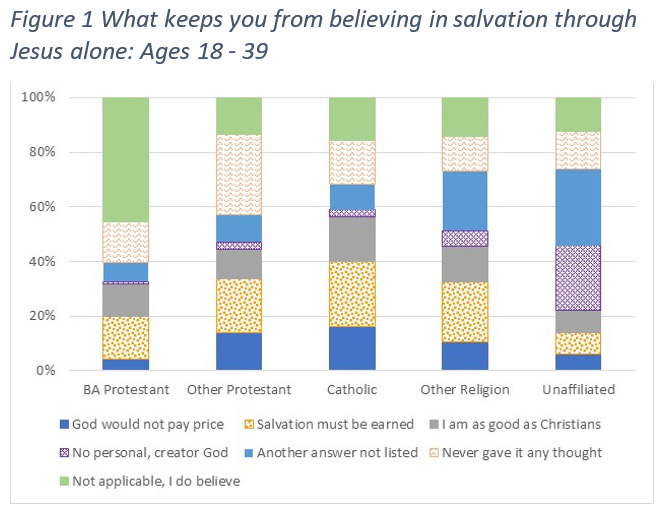
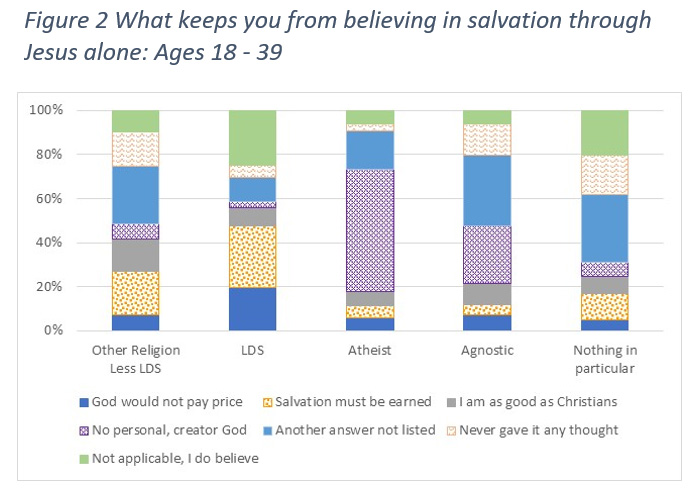 To get a better understanding of what drives these results, we dove further into the makeup of each of these two groups. The results are shown in Figure 2.
To get a better understanding of what drives these results, we dove further into the makeup of each of these two groups. The results are shown in Figure 2.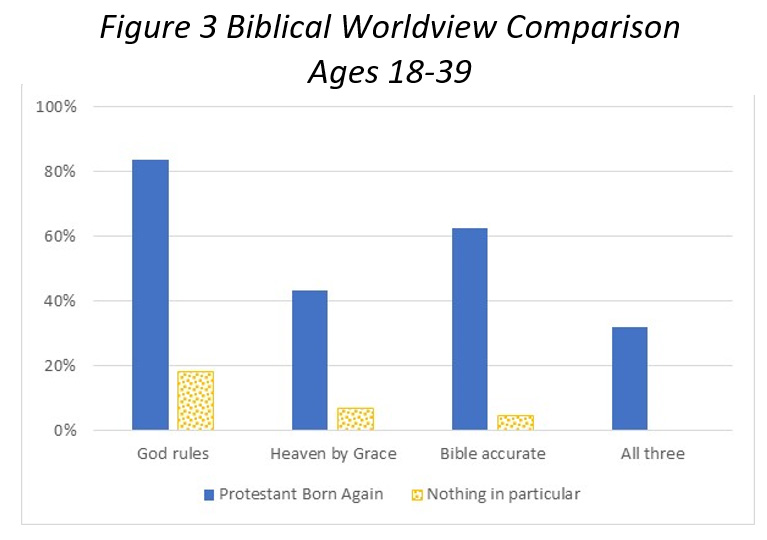 Let’s compare the results for Born-again Protestants and those who claimed to be Nothing in Particular. As shown in Figure 3, for each of the questions those agreeing with a biblical worldview among the Nothing in Particulars is a small fraction of those among Born-again Protestants. When we combine the three questions together, we see one out of three Born-again Protestants vs. no NIPs. Certainly, some of these NIPs came from an evangelical background, but none of them interviewed in our survey ascribe to a basic evangelical worldview as adults. As noted in our first report, one in three orn-again Protestants is a disappointing percentage ascribing to these biblical worldview questions, but it is certainly dramatically better than the Nothing in Particular group.
Let’s compare the results for Born-again Protestants and those who claimed to be Nothing in Particular. As shown in Figure 3, for each of the questions those agreeing with a biblical worldview among the Nothing in Particulars is a small fraction of those among Born-again Protestants. When we combine the three questions together, we see one out of three Born-again Protestants vs. no NIPs. Certainly, some of these NIPs came from an evangelical background, but none of them interviewed in our survey ascribe to a basic evangelical worldview as adults. As noted in our first report, one in three orn-again Protestants is a disappointing percentage ascribing to these biblical worldview questions, but it is certainly dramatically better than the Nothing in Particular group.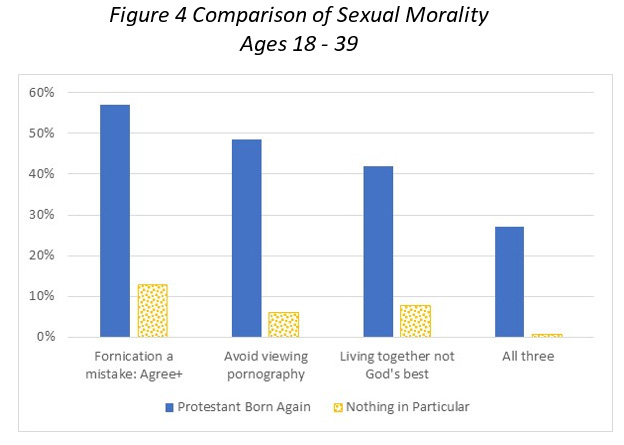 The results from our survey are shown in Figure 4. Once again, we see a large difference between these two groups. Clearly, the NIPs do not ascribe to a biblical view on sexual morality. The majority of Born-again Protestants do not ascribe to those beliefs either, but a significant minority of them do.
The results from our survey are shown in Figure 4. Once again, we see a large difference between these two groups. Clearly, the NIPs do not ascribe to a biblical view on sexual morality. The majority of Born-again Protestants do not ascribe to those beliefs either, but a significant minority of them do.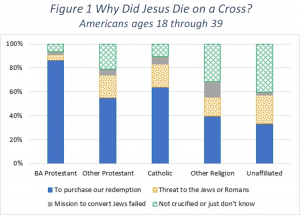 The responses for ages 18 through 39 are shown in Figure 1. As shown, Born Again Protestants have a far greater percentage, over 85%, stating that Jesus was crucified to purchase our redemption. One would suspect that all Protestant and Catholic leaders would want their people to know that Jesus’ death on the cross was for their redemption. Yet, less than two thirds of each group selected that answer. Note that the answer to this question did not say that salvation was through grace alone. So even those with a works-based gospel should still select that answer.
The responses for ages 18 through 39 are shown in Figure 1. As shown, Born Again Protestants have a far greater percentage, over 85%, stating that Jesus was crucified to purchase our redemption. One would suspect that all Protestant and Catholic leaders would want their people to know that Jesus’ death on the cross was for their redemption. Yet, less than two thirds of each group selected that answer. Note that the answer to this question did not say that salvation was through grace alone. So even those with a works-based gospel should still select that answer.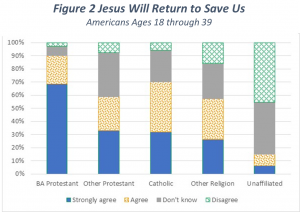 The results for this question follow a similar pattern to those for the first question above with a little less surety shown among Christians. As shown, just over two thirds of Born Again Protestants strongly agree that Jesus will return to save. Meaning that almost one third of them are not absolutely sure of Jesus’ return.
The results for this question follow a similar pattern to those for the first question above with a little less surety shown among Christians. As shown, just over two thirds of Born Again Protestants strongly agree that Jesus will return to save. Meaning that almost one third of them are not absolutely sure of Jesus’ return.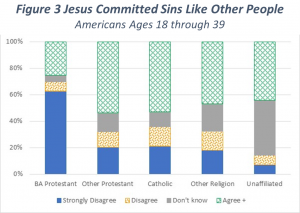 Young adult American beliefs about this statement follow a similar pattern as the first two questions. Once again, about one third of Born Again Protestants either Don’t Know or Agree with this statement. Having this large a number of Born Again Protestants who don’t accept a primary belief of Biblical Christianity is disappointing.
Young adult American beliefs about this statement follow a similar pattern as the first two questions. Once again, about one third of Born Again Protestants either Don’t Know or Agree with this statement. Having this large a number of Born Again Protestants who don’t accept a primary belief of Biblical Christianity is disappointing.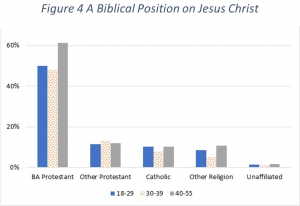 What happens when we look at how many Born Again Protestants take a biblically consistent view on all three of these questions? Consider the results shown in Figure 4. First, we see that young adult Born Again Protestants drop from about two thirds for the individual questions down to about one half when looking at all three questions. It appears that about one half of those categorized as Born Again Protestants are trusting Jesus to save them but do not have a good understanding of biblical teaching on Jesus.
What happens when we look at how many Born Again Protestants take a biblically consistent view on all three of these questions? Consider the results shown in Figure 4. First, we see that young adult Born Again Protestants drop from about two thirds for the individual questions down to about one half when looking at all three questions. It appears that about one half of those categorized as Born Again Protestants are trusting Jesus to save them but do not have a good understanding of biblical teaching on Jesus.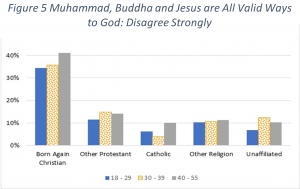 First let’s look at just question number one across the various religious groups, looking for the answer Disagree strongly as shown in Figure 5
First let’s look at just question number one across the various religious groups, looking for the answer Disagree strongly as shown in Figure 5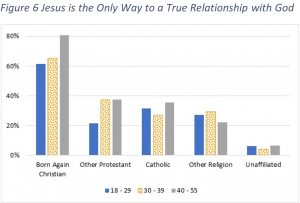 Instead, we asked this second question in a slightly different way but with the same intent: “I believe that the only way to a true relationship with God is through Jesus Christ.” We thought that this question would be
Instead, we asked this second question in a slightly different way but with the same intent: “I believe that the only way to a true relationship with God is through Jesus Christ.” We thought that this question would be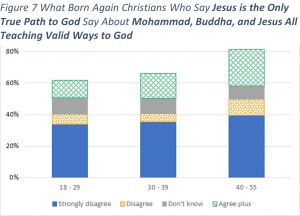 However, the survey respondents show us that one does not have to give answers which logically support one another. Even if some of the respondents misread the statement, the difference between the two is great enough that it is safe to assume that the results are not primarily attributable to misreading.
However, the survey respondents show us that one does not have to give answers which logically support one another. Even if some of the respondents misread the statement, the difference between the two is great enough that it is safe to assume that the results are not primarily attributable to misreading.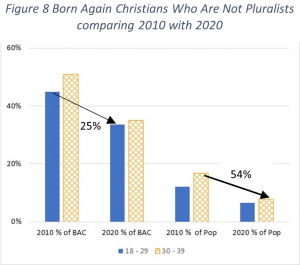 How have the statistics on Born Again Christians and pluralism changed from 2010 to 2020? As shown in the figure, we see a significant drop in the percent of BACs who are not pluralists. Those age 18 to 29 drop by 25% (from 45% to 34% of all BACs) and those age 30 to 39 drop by 31% (from 51% to 35% of all BACs).
How have the statistics on Born Again Christians and pluralism changed from 2010 to 2020? As shown in the figure, we see a significant drop in the percent of BACs who are not pluralists. Those age 18 to 29 drop by 25% (from 45% to 34% of all BACs) and those age 30 to 39 drop by 31% (from 51% to 35% of all BACs).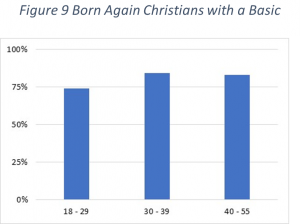 What about that smaller subset of people who have a Basic Biblical Worldview? Do a majority of them also have a pluralistic worldview? The answer is no. As shown, between 75% and 85% of them are not pluralists.
What about that smaller subset of people who have a Basic Biblical Worldview? Do a majority of them also have a pluralistic worldview? The answer is no. As shown, between 75% and 85% of them are not pluralists.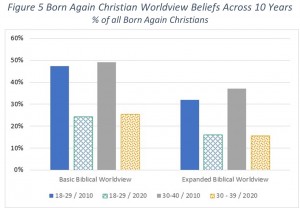 Now let’s compare these 2020 results with the results from our 2010 survey. Figure 5 shows the results across this decade for Born Again Christians looking at the percent who agree with the worldview answers above. As shown, there has been a dramatic drop in both the Basic Biblical Worldview and the Expanded Biblical Worldview.
Now let’s compare these 2020 results with the results from our 2010 survey. Figure 5 shows the results across this decade for Born Again Christians looking at the percent who agree with the worldview answers above. As shown, there has been a dramatic drop in both the Basic Biblical Worldview and the Expanded Biblical Worldview.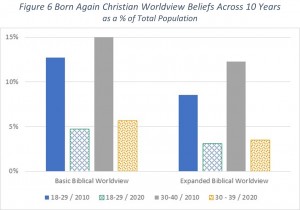 However, because the percent of the population who profess to being born again has dropped over the last ten years as well, the situation is even worse. We need to look at the percent of Americans of a particular age range who hold to a Biblical Worldview. Those results are shown in Figure 6. Once again, comparing the 18–29 age group from 2010 with the same age group ten years later now 30–39, we find an even greater drop off. For the Basic Biblical Worldview, we see a drop off from 13% of the population down to 6%. For the Expanded Biblical Worldview, the decline is from 9% down to just over 3% (a drop off of two thirds).
However, because the percent of the population who profess to being born again has dropped over the last ten years as well, the situation is even worse. We need to look at the percent of Americans of a particular age range who hold to a Biblical Worldview. Those results are shown in Figure 6. Once again, comparing the 18–29 age group from 2010 with the same age group ten years later now 30–39, we find an even greater drop off. For the Basic Biblical Worldview, we see a drop off from 13% of the population down to 6%. For the Expanded Biblical Worldview, the decline is from 9% down to just over 3% (a drop off of two thirds).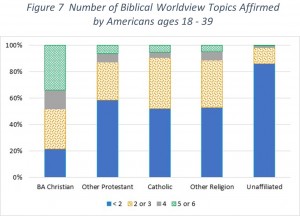 Rather than look at the two biblical worldview levels discussed above, we will look at how many of the six biblical worldview questions they answered were consistent with a biblical worldview. In the chart, we look at 18- to 39-year-old individuals grouped by religious affiliation and map what portion answered less than two of the questions biblically, two or three, four, or more than four (i.e., five or six).
Rather than look at the two biblical worldview levels discussed above, we will look at how many of the six biblical worldview questions they answered were consistent with a biblical worldview. In the chart, we look at 18- to 39-year-old individuals grouped by religious affiliation and map what portion answered less than two of the questions biblically, two or three, four, or more than four (i.e., five or six).